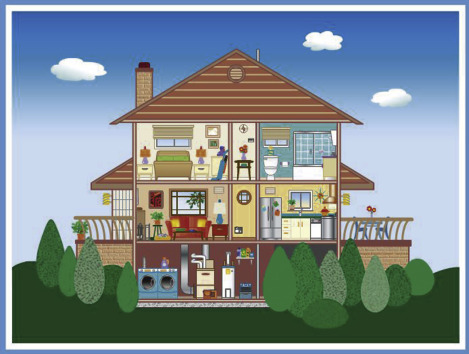Living in Delhi NCR means you are constantly living in Air Pollution. This has become a severe problem and it has many adverse effects on our body. Air Pollution is not just limited to the outside but there are many pollutants found even inside our homes. The indoor air can get toxic with particulate matter like dust, smoke, allergens, mould, and gases like VOCs (volatile organic compounds) alongside chemical fumes from cooking and heating. Exposure to indoor air pollutants can result in a range of health effects, such as eye and throat irritation, asthma and other respiratory diseases and cancer. Air Pollution is even more harmful for small children. As we are spending so much time indoors, take the below measures to make your home pollution free.
Use an effective Air Purifier
This is one of the most crucial step to eliminate air pollution inside homes. Use a good quality purifier with Hepa Filters to clean the air inside the home to eliminate harmful toxins, dust , smoke and particles.
Proper Ventilation
A proper ventilation can help to reduce indoor air pollution. When indoor spaces are not adequately ventilated, pollutants can build up to dangerous levels. This is especially a concern in homes that are sealed tight to conserve energy. Inadequate ventilation can also lead to a build-up of carbon dioxide, which can cause health problems, including headaches, dizziness, and fatigue. Open the windows everyday so that the stale and polluted indoor air is replaced with fresh outdoor air.
Use Indoor Plants
Keeping indoor plants helps to keep the air clean to some extent. Indoor plants help to purify the air by absorbing contaminants and releasing oxygen. Additionally, indoor plants help to improve indoor air quality by increasing humidity and reducing dust levels. These plants clean the air in your environment and give you a much cleaner and healthier surrounding.
Select plants known for their ability to filter air pollutants, as recommended by NASA’s Clean Air Study, which identified species that remove harmful substances from the air. You also want to choose plants that thrive in your specific lighting and environmental conditions. But Having one plant won’t be effective at purifying the air, especially for larger spaces. It’s best to get multiple plants, paired with an actual air purifier, as well as removing anything that is emitting toxins in the home to truly make air purification effective.
How plants Purify the air
Photosynthesis is a process that involves plants converting the carbon dioxide we exhale into fresh oxygen and eliminating toxins from the air. Many houseplants are known for purifying the air and removing toxic chemicals as mentioned below.
Some plants remove Formaldehyde from the air which causes irritation to mouth, throat, and nose.
Benzene can lead to drowsiness, dizziness and headaches, and can eventually cause harmful effects on the bone marrow and a decrease in red blood cells.
Trichloroethylene, which can result in dizziness, headache, confusion and weakness.
Below is a list of some Plants which help to purify the air and remove these above mentioned chemicals.
Aleo Vera
If provided with ample sunlight this plant can easily survive in any space. This plant also doesn’t need much watering. It’s known to remove formaldehyde and benzene, and it also releases oxygen at night, making it a great plant for bedrooms. It has fleshy leaves which has aleo vera gel that’s often used to soothe skin and hydrate hair.
Pothos
Pothos is effective at filtering toxins like carbon monoxide, benzene, formaldehyde, xylene, and toluene. Plus, they’re very easy to care for. But these plants are toxic to pets so be careful if you are a pet owner. Indirect light and well drained soil is required for these to grow.
Lilyturf
It is also called monkey grass. The tall, hardy plant that prefers well-drained soil and partial shade. Keep in mind that pests like mealybugs and aphids can grow in these. These can be easily potted in small containers and kept near windowsills.
Queen Fern
This plant grows well in bright area with indirect light but can survive in the direct sun if the soil is kept moist. It also needs humidity to grow well.
Snake Plant
This plant can survive even in little water and light. Because it can go weeks without care, it’s known as one of the most low-maintenance houseplants for beginner gardeners. It’s effective at removing toxins such as formaldehyde, benzene and trichloroethylene and like aloe vera, it also releases oxygen at night
Gerbera Daisy
Add cheer to your interior with this colorful daisy, which has been found to remove formaldehyde, benzene and trichloroethylene from the air. While growing the plant indoors can be tricky, you can also grow them in your backyard and display the cuttings in a vase.
Chrysanthemums
You’ll find these colorful flowers everywhere, especially in the fall. According to NASA, chrysanthemums are among the best air-purifying houseplants as they remove most indoor pollutants like formaldehyde, benzene and xylene. The flowering plant requires very little care, but it’ll only stay alive for a few weeks indoors.
No smoking indoors
The smoke from the cigarettes and cigars is very harmful. The smoke from these release pollutants in the air which is very harmful to the lungs. Make sure to not smoke inside the house. Passive smoking is even more harmful than active smoking and can lead lung cancer.
Clean the Home Regularly
It is very important to keep your home clean . There are so many pollutants and dust settled on our beds, furniture and all surroundings around the house. Use a damp cloth and dust the home and use a Vacuum cleaner with Hepa filter to remove all the dust and pollutants from the house. Vacuum cleaning helps to remove the dust even from the air inside the house and makes the home clean and breathable with unpolluted air.
Dust can harbor pollen, pet dander, bacteria, mites, mold, and mildew. Therefore, dust furnishing and vacuum cleaning regularly is crucial
Use toxin free cleaning products
Avoid the use of cleaning products and fragrances that have a pine or citrus scent because these can react with ozone to form particles and formaldehyde. Reduce or restrict the use of consumer products that produce ozone, such as residential laundry water treatment systems, ozone fruit and vegetable washers, and/or ozone hair and facial tools. Many conventional cleaning products contain harmful chemicals that cause indoor air pollution. To avoid this, choose green cleaners made with natural ingredients like white vinegar, baking soda, borax, citrus fruit, and essential oils.
Keep indoor space Dry
To reduce mould, keep moisture down by using a dehumidifier and cleaning the filter regularly. Always keep the washrooms and rooms clean and dry as wet areas can lead to mold and fungus in the house which is very harmful and releases harmful chemicals in the air causing air pollution . Mould is an indoor air pollutant that can cause myriad health problems, including respiratory infections, asthma, and allergies. For those with weakened immune systems or pre-existing conditions like asthma or allergies, mould exposure can exacerbate illnesses and cause serious respiratory infections.
Reduce using Plastic and Synthetic Material Indoor
Plastic and Synthetic material release very harmful chemicals. Avoid air fresheners, scented candles, incense, and other odor-masking fragrances, which can trigger asthma.
Use Exhaust Fans
Run fans in the kitchen to remove cooking fumes and in bathrooms to remove steam. Also be sure that your dryer vents to the outside to minimize lint. To reduce the level of pollen in the air on days it’s not possible to open the windows, run your window air conditioner on the fan setting with a clean filter.
Conclusion
The future on controlling the air pollution side homes lies in technology. Currently, several air purifiers in the market use cutting-edge technology to remove indoor air pollutants. Indoor air pollutants can now be detected with more precise, efficient and compact sensors thanks to advances in environmental sensing technology. As a result, intelligent home systems use sensors like these to keep track of indoor air quality and notify the ventilation system before dangerous levels are reached.
In the future, indoor air pollution may also be controlled through nanotechnology, which works by trapping or destroying indoor contaminants on a molecular level. This technology is already being developed for air purifiers and can potentially remove indoor pollutants at a much smaller scale than current methods.
In the current scenario it is crucial to address the issue of air pollution and work towards improving it for us and the future generation. These are some steps which will bring bigger changes in the future.

